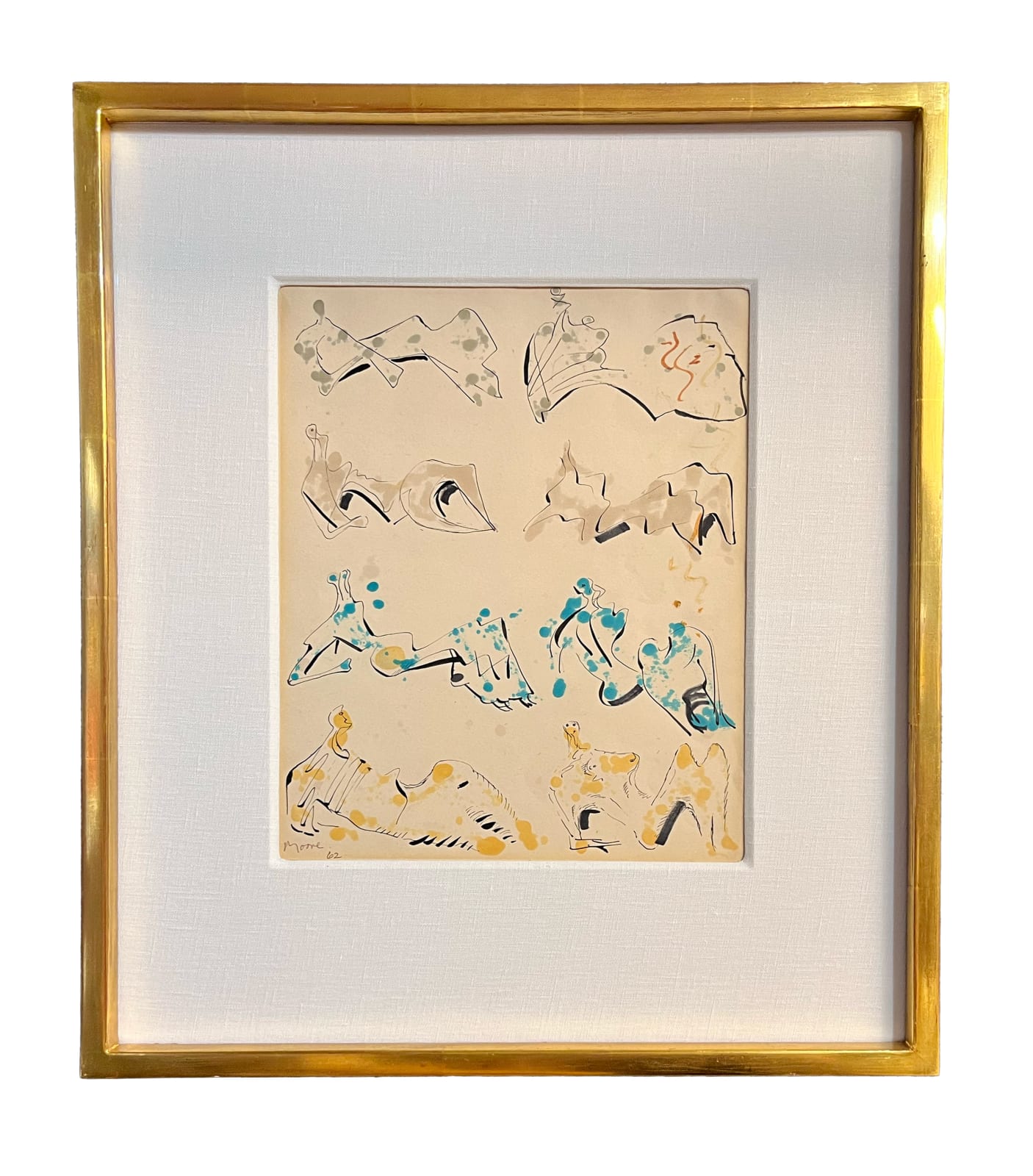Henry Moore British, 1898-1986
Eight Reclining Figures, 1962
Coloured felt-tip pen, pen and India ink on paper
29.2 x 23.3 cm unframed
48.5 x 40.5cm framed
Artwork location: Hale Gallery
48.5 x 40.5cm framed
Artwork location: Hale Gallery
Copyright The Artist
Signed and dated 'Moore. 62.' (lower left); inscribed and dated '8 Reclining Figures. 1962 (Blue Green + Yellow)' (verso) 'Eight Reclining Figures,' created by the acclaimed British artist Henry Moore...
Signed and dated 'Moore. 62.' (lower left); inscribed and dated '8 Reclining Figures. 1962 (Blue Green + Yellow)' (verso)
"Eight Reclining Figures," created by the acclaimed British artist Henry Moore in 1962, is a captivating work on paper that showcases Moore's mastery of form, abstraction, and exploration of the human figure.
The drawing depicts a series of reclining figures arranged in a dynamic composition. Moore's signature style is evident in the organic and curvilinear forms that make up each figure. The smooth, undulating contours create a sense of fluidity and movement, despite the figures' static nature.
The use of negative space is a defining element of Moore's practice, and "Eight Reclining Figures" exemplifies this aspect of his work. The interplay between the solid forms and the voids between them adds depth and dimension to the piece. The negative spaces become as important as the physical figures themselves, inviting the viewer to contemplate the relationship between presence and absence.
Moore's fascination with the human form is apparent in "Eight Reclining Figures." While the figures are abstracted and stylized, the essential characteristics of reclining bodies are still discernible. The artist captures the inherent beauty and grace of the human figure, emphasizing the natural curves and contours that evoke a sense of comfort and repose.
Beyond its formal qualities, the drawing carries symbolic and universal themes. The reclining figures evoke a sense of serenity, contemplation, and introspection. They represent the timeless human experience of rest and relaxation, inviting the viewer to connect with the fundamental aspects of human existence.
Henry Moore's "Eight Reclining Figures" is a testament to his artistic genius, demonstrating his ability to transform the human figure into abstracted, yet evocative forms.
"Eight Reclining Figures," created by the acclaimed British artist Henry Moore in 1962, is a captivating work on paper that showcases Moore's mastery of form, abstraction, and exploration of the human figure.
The drawing depicts a series of reclining figures arranged in a dynamic composition. Moore's signature style is evident in the organic and curvilinear forms that make up each figure. The smooth, undulating contours create a sense of fluidity and movement, despite the figures' static nature.
The use of negative space is a defining element of Moore's practice, and "Eight Reclining Figures" exemplifies this aspect of his work. The interplay between the solid forms and the voids between them adds depth and dimension to the piece. The negative spaces become as important as the physical figures themselves, inviting the viewer to contemplate the relationship between presence and absence.
Moore's fascination with the human form is apparent in "Eight Reclining Figures." While the figures are abstracted and stylized, the essential characteristics of reclining bodies are still discernible. The artist captures the inherent beauty and grace of the human figure, emphasizing the natural curves and contours that evoke a sense of comfort and repose.
Beyond its formal qualities, the drawing carries symbolic and universal themes. The reclining figures evoke a sense of serenity, contemplation, and introspection. They represent the timeless human experience of rest and relaxation, inviting the viewer to connect with the fundamental aspects of human existence.
Henry Moore's "Eight Reclining Figures" is a testament to his artistic genius, demonstrating his ability to transform the human figure into abstracted, yet evocative forms.
Provenance
Gimpel Fils, London.
Galerie Krugier, Zurich (acquired in 1966).
Gimpel & Hanover Galerie, Zurich.
Private collection, Massachusetts (acquired from the above in August 1967).
Thence by descent to the present owner.




